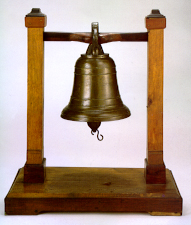
40 x 26 x 46.5
Wood and bronze
INDEX 1788 : S.VII.507
Campana aena suspensa inter duas parastatas ligneas, quae percussa evadit ovata, uti ex impactu in cochleam eminentem patet.
A bronze bell suspended between two wooden columns, which when struck becomes oval, as is evident from the prominent screw, on account of the impact.
This apparatus was used to prove that bodies distort when they vibrate. The material consists of a bronze bell (bell and clapper) fixed in a horizontal wooden beam supported by two vertical columns erected on a rectangular piece of wood that forms the base. The corresponding equipment described by Desaguliers, to whom dalla Bella refers, was not strictly speaking a bell, but only a glass bell jar arranged analogously to that found in the Physics Museum.
Striking the bell jar made it vibrate, consequently causing its circular mouth to take an elliptical shape, although this was not perceptible to the naked eye. In order to make this phenomenon visible, Desaguliers' equipment had a screw that passed horizontally through one of the support columns, whose point could be brought near to the glass of the bell jar, exactly at the edge of the mouth. With the bell jar at rest there was a small space between the point of the screw and the glass. By striking the glass, the deformation of the mouth made it touch the point of the screw, which could be observed easily either by seeing the small space disappear or by the change the ear would notice in the sound.
In the example in the Physics Museum there does not appear to be a place for such a screw, but on the inside of each of the support columns there is some evidence that something existed there. Perhaps spikes of a suitable length were fixed instead of normal screws.
From Colégio dos Nobres, catalogue n.º 494.
Carvalho, Rómulo de, História do Gabinete de Física da Universidade de Coimbra, Universidade de Coimbra, Biblioteca Geral, Coimbra, 1978, p. 619.
Desaguliers, Jean-Théophile, A Course of Experimental Philosophy, London, 1734, Vol. II, p. 9, Pl. I, Fig. 10.